

European Union. Summaries of EU legislation. Transport. Road transport. We are migrating the content of this website during the first semester of 2014 into the new EUR-Lex web-portal.
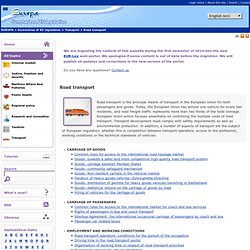
We apologise if some content is out of date before the migration. We will publish all updates and corrections in the new version of the portal. Do you have any questions? Contact us. Ttransportable pressure equipment. This directive updates certain technical provisions of Directive 1999/36/EC to avoid conflicting rules.
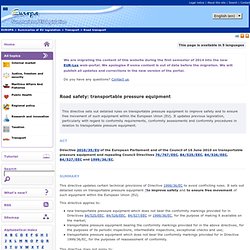
It sets out detailed rules on transportable pressure equipment *to improve safety and to ensure free movement of such equipment within the European Union (EU). This directive applies to: new transportable pressure equipment which does not bear the conformity markings provided for in Directives 84/525/EEC, 84/526/EEC, 84/527/EEC or 1999/36/EC, for the purpose of making it available on the market; transportable pressure equipment bearing the conformity markings provided for in the above directives, for the purposes of its periodic inspections, intermediate inspections, exceptional checks and use; transportable pressure equipment which does not bear the conformity markings provided for in Directive 1999/36/EC, for the purposes of reassessment of conformity.
This directive does not apply to: Obligations of economic operators * Importers, distributors and owners must: Inland transport of dangerous goods. Directive 2008/68/EC of the European Parliament and of the Council of 24 September 2008 on the inland transport of dangerous goods.
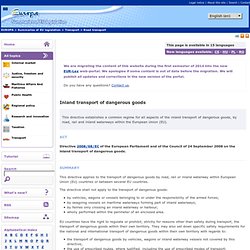
This directive applies to the transport of dangerous goods by road, rail or inland waterway within European Union (EU) countries or between several EU countries. The directive shall not apply to the transport of dangerous goods: by vehicles, wagons or vessels belonging to or under the responsibility of the armed forces; by seagoing vessels on maritime waterways forming part of inland waterways; by ferries only crossing an inland waterway or harbour; wholly performed within the perimeter of an enclosed area. EU countries have the right to regulate or prohibit, strictly for reasons other than safety during transport, the transport of dangerous goods within their own territory.
They may also set down specific safety requirements for the national and international transport of dangerous goods within their own territory with regards to: Checks on the transport of dangerous goods by road. Council Directive 95/50/EC of 6 October 1995 on uniform procedures for checks on the transport of dangerous goods by road [See amending acts].

This directive applies to checks carried out by European Union (EU) countries on the transport of dangerous goods by road in vehicles travelling in their territory or entering it from a third country. Air transport. Groundhandling at Community airports. We are migrating the content of this website during the first semester of 2014 into the new EUR-Lex web-portal.
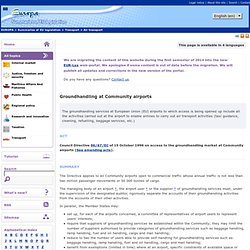
We apologise if some content is out of date before the migration. We will publish all updates and corrections in the new version of the portal. Do you have any questions? Contact us. Council Directive 96/67/EC of 15 October 1996 on access to the groundhandling market at Community airports [See amending acts]. Consumers. Consumer safety. Product safety: general rules. Directive 2001/95/EC of the European Parliament and the Council of 3 December 2001 on general product safety [Official Journal L 11 of 15.1.2002].

This Directive applies in the absence of specific European regulations, governing the safety of certain categories of products or if specific regulations (sectoral) are insufficient. Furthermore, it is to be applied without prejudice to Directive 85/374/EEC concerning liability for defective products. General safety requirement The Directive imposes a general safety requirement on any product put on the market for consumers or likely to be used by them, including all products that provide a service. Second-hand products that have antique value or those that need to be repaired are not subject to this requirement. Product labelling and packaging. We are migrating the content of this website during the first semester of 2014 into the new EUR-Lex web-portal.

We apologise if some content is out of date before the migration. We will publish all updates and corrections in the new version of the portal. Do you have any questions? Contact us. The objective of foodstuff labelling is to guarantee that consumers have access to complete information on the content and composition of products, in order to protect their health and their interests. Labelling of certain non-food products must also contain particular information, in order to guarantee their safe use and allow consumers to exercise real choice. Marketing of products - CE conformity marking. This common framework for the marketing of products sets out: common definitions; common conformity assessment procedures; obligations for economic operators (manufacturers, importers and distributors); rules for the use of the EC marking, thereby making it possible to increase trust in the products marketed in the EU; notification criteria for the conformity assessment bodies; safeguard procedures.
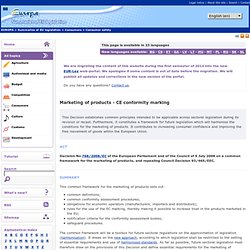
The common framework will be a toolbox for future sectoral regulations on the approximation of legislation (harmonisation). It draws on the new approach, according to which legislation shall be restricted to the setting of essential requirements and use of harmonised standards. As far as possible, future sectoral legislation must therefore draw on the provisions of this Decision and define essential requirements for the marketing of products. Where necessary, specific legislation may nevertheless offer other solutions.
Definitions Obligations of manufacturers, importers and distributors Context. Internal market. Accreditation and market surveillance. This Regulation envisages the laying down of clear rules on the organisation and operation of accreditation, in the Member States, of conformity assessment bodies performing assessment of any substance, preparation or other product, transformed or not, to be placed on the Community market.

It is important to guarantee a high level of market surveillance in order to satisfy the requirements of protection of public interests such as health and safety in general, health and safety in the workplace, protection of consumers, the environment and security. These rules reinforce the existing system, without weakening existing instruments such as the General Product Safety Directive, which has on the whole been successful. Accreditation This Regulation provides a framework for European accreditation policy.
Single Market for Goods. We are migrating the content of this website during the first semester of 2014 into the new EUR-Lex web-portal.
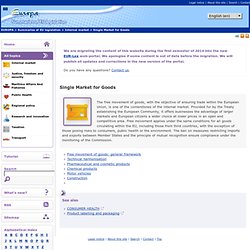
We apologise if some content is out of date before the migration. We will publish all updates and corrections in the new version of the portal. Do you have any questions? Contact us. Technical harmonisation. Electrical equipment designed for use within certain voltage limits. Directive 2006/95/EC of the European Parliament and of the Council of 12 December 2006 on the harmonisation of the laws of Member States relating to electrical equipment designed for use within certain voltage limits (codified version) (Text with EEA relevance).
This Directive aims at ensuring that electrical equipment may be placed on the market only if it does not, when installed and maintained, endanger the safety of persons, domestic animals or property, and at promoting the free movement of this equipment in the European Union. Scope This Directive applies to electrical equipment designed for use with a voltage rating of between 50 and 1000 Volts for alternating current and between 75 and 1500 Volts for direct current. It does not apply to: Safety objectives. Pressure equipment. This Directive aims to harmonise the national legislation of Member States concerning the design, manufacture, testing and conformity assessment of: pressure equipment; assemblies of pressure equipment constituting an integrated whole.
It seeks to ensure that the relevant equipment in the European Union (EU) and certain other associated countries, such as those in the European Economic Area (EEA), can be placed on the market freely. Scope The Directive's provisions apply to equipment subject to a maximum allowable pressure greater than 0.5 bar (i.e. 0.5 bar above atmospheric pressure) that poses a hazard due to pressure. The Directive does not apply to: A new approach to technical harmonisation. The main aim of this Resolution is to develop an approach establishing general rules which are applicable to sectors or families of products as well as types of hazard.
This Resolution establishes a number of fundamental principles for a European standardisation policy: Construction. Construction products. This Regulation sets out the conditions for the marketing of construction products *. It also defines criteria for assessing the performance * of such products, and the conditions of use for CE marking. Declaration of performance and CE marking Where a manufacturer decides to place a construction product on the market and that product is covered by a harmonised standard, it must complete a declaration of performance which contains, in particular, the following information: Enterprise. Enterprise and Industry. Policy. Harmonised standards. A harmonised standard is a European standard elaborated on the basis of a request from the European Commission to a recognised European Standards Organisation to develop a European standard that provides solutions for compliance with a legal provision.
Such a request provides guidelines which requested standards must respect to meet the essential requirements or other provisions of relevant European Union harmonisation legislation... Compliance with harmonised standards provides a presumption of conformity with the corresponding requirements of harmonisation legislation. Manufacturers, other economic operators or conformity assessment bodies can use harmonised standards to demonstrate that products, services or processes comply with relevant EU legislation. Mandate. Single market for goods. The single market for goods is one of the Union's most important and continuing priorities which aims to create a user-friendly environment for businesses and consumers. Reference documents: blue guide - Single market for goods - Enterprise and Industry. Regulatory policy: common rules for products - Single market for goods - Enterprise and Industry.
CE marking - Single market for goods. Market Surveillance Authorities. CE marking. CE marking for consumers. CE marking - Basics. CE marking for professionals. For Importers. For Distributers. Equipment Categories. Low Voltage. Directives As a first step, you need to verify whether your product(s) fall(s) within the definition of an active implantable medical device in accordance with Article 1 paragraph 2a) to c) of Directive 90/385/EEC where also the term "active medical device" is defined. Electromagnetic Compatability. Directives As a first step, you need to verify whether your product(s) fall(s) within the definition of an active implantable medical device in accordance with Article 1 paragraph 2a) to c) of Directive 90/385/EEC where also the term "active medical device" is defined. For a definition of "implantable device" see Annex IX, section I.1.2 of Directive 93/42/EEC on medical devices. Secondly, you need to verify that none of the exclusion clauses of Article 1 paragraph 3 to 6 is applicable.
If all these conditions are fulfilled, Directive 90/385/EEC applies. Machinery. Directives As a first step, you need to verify whether your product(s) fall(s) within the definition of an active implantable medical device in accordance with Article 1 paragraph 2a) to c) of Directive 90/385/EEC where also the term "active medical device" is defined. ATEX. Directives As a first step, you need to verify whether your product(s) fall(s) within the definition of an active implantable medical device in accordance with Article 1 paragraph 2a) to c) of Directive 90/385/EEC where also the term "active medical device" is defined. Standards. Harmonised standards.
Measuring Instruments. Mutual recognition. Databases and applications. NANDO. Technical Barriers to Trade. Industry sectors overview - Enterprise and Industry. Aeronautic industries. Construction. Eurocodes - Construction. Eurocodes. Nationally Determined Parameters. Mandatory? DIRECTIVE 2004/18/EC. EN Eurocodes & Related Standards. Execution Standards. Product Standards. Test Standards. ISO Standards. Explore Construction - The European Construction Information Platform. Parts and Packages. EN 1990: Basis of Structural Design. EN 1991: Actions on structures. EN 1992: Design of concrete structures.
EN 1993: Design of steel structures. EN 1994: Design of composite steel and concrete structures. EN 1997: Geotechnical design. EN 1998: Design of structures for earthquake resistance. Www.confinedmasonry.org/wp-content/uploads/2009/09/Eurocode-8-1-Earthquakes-general.pdf. EN 1999: Design of aluminium structures. EU policies and legislation impacting construction. Database on dangerous substances (CP-DS) Electrical engineering. Electromagnetic Compatibility (EMC) Standardisation. Electrical Safety: Low Voltage Directive (LVD) - Electrical engineering - Enterprise and Industry. Legal metrology and pre-packaging. Legal metrology and pre-packaging. European standards. OIML Guidance documents. Mechanical engineering.
Directive 94/9/EC on equipment and protective systems intended for use in potentially explosive atmospheres (ATEX) - Mechanical engineering - Enterprise and Industry. Pressure equipment and gas appliances.
The Chinese Central Government. Standardiazation Admin. NIM. General Administration of Quality Supervision,Inspection and Quarantine of the PRC (AQSIQ) China National Institute of Standardization. Members > China (CN) U.S. Department of Commerce CCC Mark info.